Director David Twohy’s Riddick is in many ways a throw-back to the low-budget R-rated original film of the popular series – Pitch Black. This time around, Riddick (Vin Diesel) finds himself stranded on a barren and sun-scarred planet filled with dangerous creatures, and people. We take a look at just some of the main visual effects shots and sequences in the film, from the Mud Demons to the jackal, to the jet bikes and the titular character’s distinctive eyeshines.
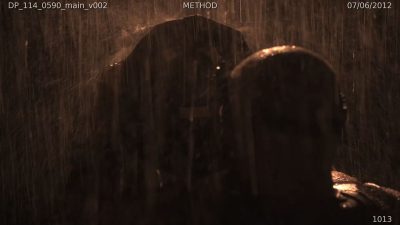
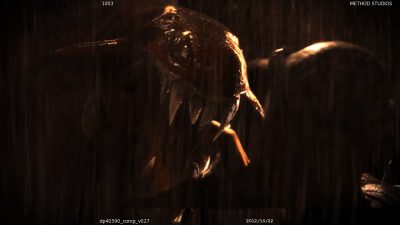
The film’s visual effects supervisor Gunnar Hansen notes that although Riddick marks a return to its indie-like roots, there were still nearly 900 visual effects shots an a host of exotic locations and creatures to imagine. An early effects challenge lay in realizing the alien world the lead character is on. “For that we did some location shooting in New Mexico on the Badlands,” says Hansen. “Trust me, if you ended up there you’d feel like you were on an alien planet. We took around 7,000 to 10,000 photographs.” Mathieu Raynault oversaw matte paintings that set the look for the volcanic, primordial and bronzed world, with several effects vendors then creating digital environments and backdrops for their particular shots.
How to make a Mud Demon

Inhabiting the desolate planet in shallow muddy pools are scorpion-like creatures known as Mud Demons. Mokko Studio crafted a range of Mud Demons from a baby through to the largest of the beasts that feature poisonous tail-daggers and pincers.
“Our modelling pipeline started with rough concept sculpts done using ZBrush Dynamesh,” explains Mokko visual effects supervisor Alain Lachance. “Once that concept was approved we would then recreate a full model with re-projected ZBrush details onto that refined mesh. Final displacement maps and bump maps were sculpted in ZBrush using HD geometry. As for our rigging pipeline, it mainly consisted of a solid set of proprietary tools and deformers. We also built rigs that were flexible enough to allow us to override points deformations and add extra controls to any part of the body.”
One particular challenge for the Mud Demons rested with their skin which had a somewhat metallic sheen – “something iridescent like fish skin,” notes Lachance. “But a chrome shader would not show up properly once light with the set’s IBL because of the set’s dark mood. There was simply nothing to reflect but dark corners. So we simply created a self-illuminated chrome shader instead which we would render as an AOV. We would then reveal it through a puzzle mat and composite it over the beauty pass. The mud coverings, dirt and slime were painted maps with procedural displacements and bumps. We added a few CG drips and slime to add to the realism of the creatures.”
The Mud Demons move around, of course, in mud. In one spectacular sequence, Riddick battles the main demon amongst a flurry of mud splashes. Live action was filmed in a pool filled with methacil which provided a terracotta look. “On set we had a two-thirds Mud Demon as a stand-in,” says Gunnar Hansen. “We had Vin on a cable pull and yanked them through the mud. We had Vin take a good run and slide on a platform that was under the mud. He just mimicked the action of slicing through the creature.”
The final shot.Mokko then incorporated its CG Mud Demon and used Naiad for the necessary mud simulations . “We experimented with many mud viscosity variations in pre-production, but once the shoot began, we studied the plates and tweaked our settings for a perfect match!”, comments Lachance. We were always trying to simulate the smallest area to gain a maximum resolution detail while keeping decent simulation and render times.”
Rendering took place in RenderMan with shaders that were slightly thicker than water for a more diffused translucency. “We also used planar projections to map various surface details like oily swirls, tiny air bubbles and thicker mud areas,” says Lachance. “In terms of integration, since shading and lighting was so close to the real thing, we would often simply soft mat our rendered mud into the plate. In cases where we could not match the full pool in the plate perfectly through lighting, we would use motion vectors to disrupt the plate’s mud surface and composite only our CG splashes.”
Raising the jackal
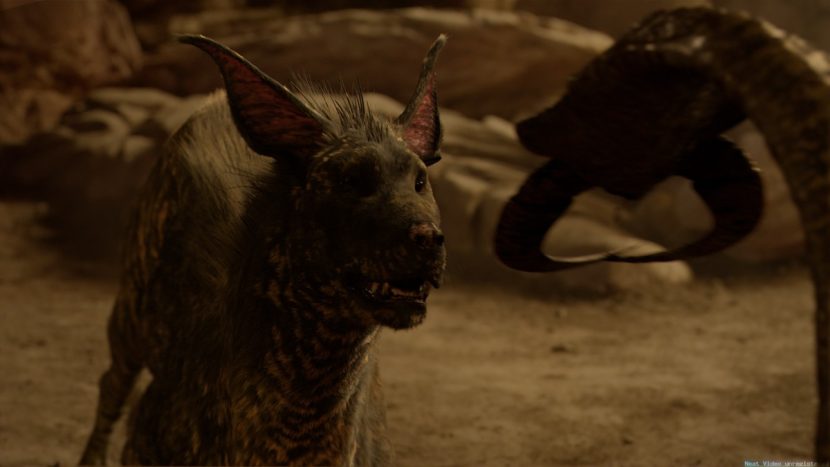
Riddick be-friends an orphaned jackal-beast pup – a digital creation by Mokko. Originally, the jackal was to be played by a real dog and then enhanced with alien features in CG so that the actors could interact with something on set. “But we felt that replacing parts was more complex,” says Lachance, “not to mention the fact of having to deal with live animals and obtaining what was needed from them on set. So it was decided that it would be a full CG creature.”
Mokko gave the jackal alien features such as parabolic ears and porcupine-like quills that form the hackles. “The fur was achieved using Yeti and the hackles were a controlled curve-based hair system the animators could use to support behaviors or emotions,” says Lachance. “All along we were always referring to and studying dogs, trying our best to capture all the details, the essence of the creature.”

Production did bring in some trained dobermans for reference. “The animation director Emilio Ghorayeb had a dog and he studied his dog very carefully,” says Hansen. “Because I know his dog, I can see some of his dog’s behavior in the Jackal. It’s a fierce creature but has some elegance in it as well. We wanted it to have some dog appeal but look alien as well. When it was in attack mode it looked a lot more fierce and you just wouldn’t want to be on the receiving end of this thing.”
For scenes of Riddick holding the jackal, a practical stuffie made by Tinsey Studio was produced to allow for contact. “We would have to match move Vin Diesel’s hand or arm anytime the dog would get in direct or indirect contact with him, if not only for shadow casting and such,” outlines Lachance. “Most of the time it was really only a matter of having the right animation, that fitted the plate’s action and intention. It was important to be clever and inspired by Vin’s movements to build around the action and to justify our animation. Obviously, lighting and integration played a major role in achieving such shots.”
Hovering hogs
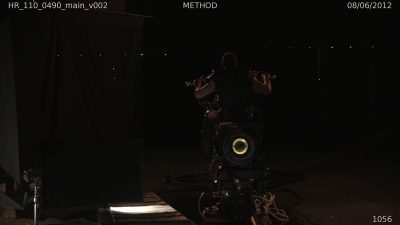
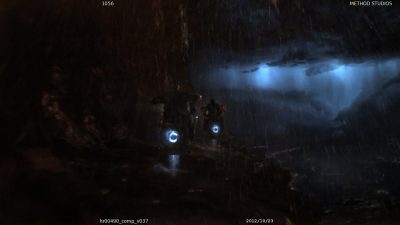
For a night chase sequence featuring hovering jet bikes, Method Studios was required to craft digital environments, machines, Mud Demons and sometimes digi-doubles. The work was led by visual effects supervisor Nordin Rahhali in Method’s LA studio and Ollie Rankin in Vancouver.
Method capitalized on bike and digi-double assets made by Modus FX for daytime scenes. Real reference came from on-set photography of the actors sitting on practical bikes, filmed against black. Scenes were made up of either fully digital bikes and actors, or a combination of both.
On-set practical bikes.“We had these bikes that are covered in chrome and metal, so shooting it on a greenscreen didn’t make sense because you be keying out all the reflections and chrome,” outlines Hansen. “It would also create an unrealistic bounce of light. So we opted to shoot against black and then do a lot of garbage matting. It was going to be a huge roto job but I think keying it would have been even more nightmarish. We were adding layers of rain on top – there was a wet down of the bikes and the actors. We had LED trackers so we knew what the camera orientation and motion was.”
A significant challenge lay in adding in a wet look with rain and lightning. “We had a lot of dry plates where either the lights would dry the bikes and actors so quickly or they didn’t have rain bars at all,” notes Rahhali. “We would take plates with practical rain and make it a storm and do the same for the plates with zero rain in them.”
/wp-content/uploads/2013/11/hr340_breakdown_H264.movWatch a breakdown of Method’s work for a jet bike scene.
“We replicated the lighting setup into our Maya scene,” adds Method CG supervisor Charles Abou Aad. “We tried to match the material response but sometimes it was easier to paint out and make CG bike from scratch.”
Taking on more Mud Demons
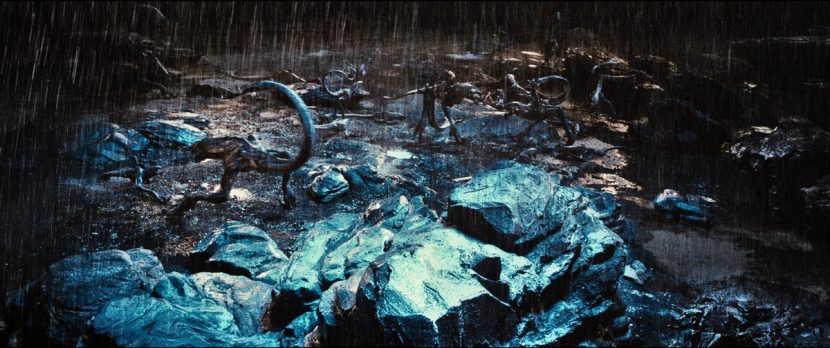
Method also contributed to shots of Riddick and character Boss Johns (Mathew Nable) fending off hordes of Mud Demons in the rain. “We had more than 100 creatures in some shots,” says Rahhali. “We had developed walk and run cycles for them and then fed that through to the bulk of the animation and then did hero animation on foreground or mid-ground. We ended up with something very creepy, where they’re almost dragging their bodies on the ground – they’re out of their element when they have to walk seeing as their suited to shallow mud pools.”
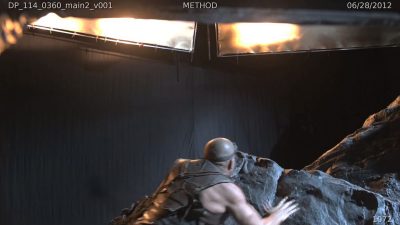

Method’s pipeline for the Mud Demon work involved ZBrush for sculpts, MARI for textures, Maya for modeling and animation, Houdini for effects and rendering in Mantra and V-Ray.
The studio moved to using the Alembic file format for Riddick to deal with the enormous amount of data with all the creature work. “In our old system,” notes Charles Abou Aad, “as soon as you got a lot of live rigs in the scene it would really bog you down. So on Riddick we switched over to Alembic caches for the majority of the creatures. It really made the scenes interactive – you could actually work with them as opposed to killing your machine.”
/wp-content/uploads/2013/11/dp40390_breakdown_H264.movMethod breaks down a sequence from the film.
Shining brightly
Watch a sequence featuring Riddick’s eyeshines from the film.A feature of Riddick’s character is his augmented eyesight, where his eyes are optimized for gathering as much light as possible. To demonstrate the nature of this vision, Comen VFX was one of the key vendors working on Riddick’s eyes. “Instead of an iris and a pupil like we have,” explains Comen visual effects supervisor Tim Carras, “Riddick has an extremely large pupil that fills up the entire front side of his eye and then his retinas are so sensitive that they collect light on the backside of his eye and you can actually see that light glowing behind his pupils – the eyeshine.”
Carras says there were three sides to the eyeshine work:
1. Creative – maintain Riddick’s performance and accentuating certain aspects. One specific shot where he has a knife in someone’s neck, and for a brief moment before he twists the knife, we put a little bit of a flash in the eye just to give it a little bit of a kiss of life.
2. Technical – trying to be as physically accurate as possible by respecting the light in the room. We would modulate the size of the glow and the intensity of the glow.
3. Tracking the eyes – it can be very challenging when he’s smaller in frame or a darker environment. It can be a hand-track but we could also rely on automated tracking and animation on top.
To tackle the eye shots, artists first had to deal with what is reflected on the cornea – the front surface of the eye. “These are specular highlights and reflections from the room, the same as we’d have on anybody’s eyes,” notes Carras, “only for him it’s a little stronger and pops a little more because of no textured iris.”
“Behind that there’s a retina and that’s the back surface of the eye and that’s where we’ve got this glow and all the collective light from the room,” adds Carras. “So when he moves his head, the eyeball tracks with his head. We offset the cornea to match that. When he changes the direction that he’s looking, that’s when we have animation going in a couple of different directions. The specular highlights are going to remain constant because those are reflected off a sphere. There’ll be a little bit of displacement happening because eyeball isn’t a perfect sphere, but by and large those highlights and reflections are staying put.”
Riddick’s retina, however, moves in the opposite direction because it’s located in the backside of the eye. “Because of how quick a human eye movement is when you dart from side to side,” says Carras, “matching that perfectly ended up looking a bit robotic and machine-like, so we often used one or two frames away and smoothed out the animation curves to give that cool blue glow in the back of the eye and give it more of a sense of life. Organic, human, not too mechanical.”
